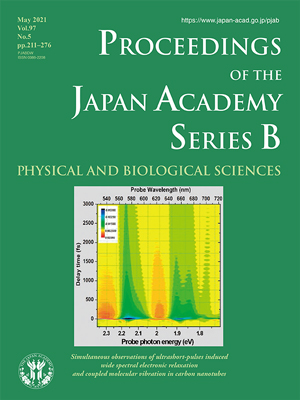About the Cover
Vol. 97 No. 5 (2021)
Photosynthesis is the largest-size chemical reaction on Earth, and artificial photosynthesis is one of the urgent topics for realizing a sustainable society. To efficiently utilize solar energy in photosynthetic and vision systems after photo-absorption should be ultrafast so as not to lose the absorbed photon energy via spontaneous fluorescence in nanoseconds and other processes. The best method to directly study photo-relevant ultrafast processes is femtosecond laser spectroscopy for coping with ultrafast processes. Our group has developed a non-collinear optical parametric amplifier (NOPA) system that holds the world-shortest pulse record of a visible-near-infrared pulse laser (see the article by Kobayashi in this issue, pp. 236-260). Our group also developed a multi-channel (128-channel) lock-in amplifier (MLA). The combined system of NOPA and MLA is powerful for femtosecond time-resolved (TR) spectroscopy, and can be applied to many ultrafast processes.
The panel shows one of typical examples of data from 2DTR-spectroscopy obtained by NOPA and MLA in the pump-probe delay range from -200 fs to 3000 fs with 1fs-steps. The pseud-color shows the pump-induced TR difference-absorption spectrum ΔA(t, λ). The inset shows the scale of the color correspondence to ΔA(t, λ). A positive ΔA(t, λ) is due to absorption by excited states or photogenerated intermediates. A negative ΔA(t, λ) involves either the bleaching of ground-state absorption due to depletion or induced emission. A cross sectional intensity profile parallel to the horizontal axis corresponds to the TR spectrum, ΔA(t,0 λ), at a delay of t0. A cross-sectional intensity profile parallel to the vertical axis shows the probe-delay time dependence of ΔA(t, λ0) after pumping at a probe wavelength of λ0, providing dynamics information concerning the species relevant to the probe wavelength.
The 2D spectrum shows an equidistant (along the delay time direction) stripe-like structure due to molecular-vibration modulated absorbance change δΔA(t, λ). The observed time-dependent absorbance change is thus ΔA(t, λ) + δΔA(t, λ). A Fourier transform (FT) of the modulation provides information concerning the molecular-vibration spectra. The powerfulness of the NOPA-MLA time-resolved spectroscopy system is its capability for obtaining both electronic relaxation and vibrational dynamics at the same time, while providing real-time molecular-structure change information during electronic relaxation. This cannot be obtained by time-resolved Raman-scattering or IR-absorption spectroscopy. The present panel data show the 2DTR spectrum measured for a mixed sample of different carbon nanotubes (CNTs) with various diameters. From the probe wavelength dependence, separate information from the contributions from different diameter CNTs can be simultaneously obtained.
Takayoshi Kobayashi
Professor Emeritus of the University of Tokyo,
Guest Professor of the University of Electro-Communications, and
Director of Advanced Ultrafast laser Center and Lifetime Chair Professor of National Chiao Tung University, Taiwan
Eiji Tokunaga
Professor, Faculty of Science Division I,
Tokyo University of Science




